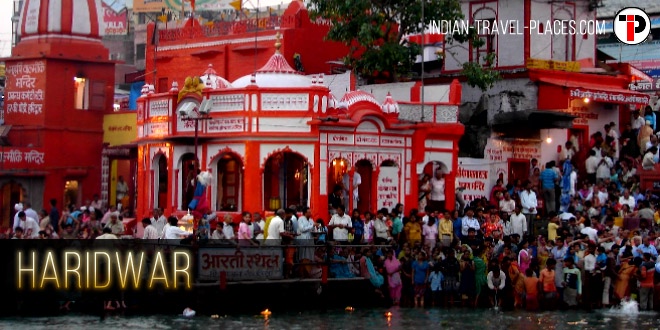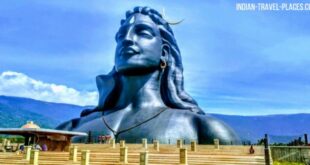Haridwar is an ancient city and important Hindu pilgrimage site in North India’s Uttarakhand state, where the River Ganges exits the Himalayan foothills. The largest of several sacred ghats (bathing steps), Har Ki Pauri hosts a nightly Ganga Aarti (river-worshipping ceremony) in which tiny flickering lamps are floated off the steps. Worshipers fill the city during major festivals including the annual Kanwar Mela.
In the following write-up, explore some interesting travel and tourism related facts about the Gateway to the God, Haridwar.
| Name: | Haridwar – ‘Gangadwara’ |
| Location: | Haridwar District, Uttarakhand, India |
| Climate: | Summers: 44° C (Max), 25° C (Min) | Winters: 24° C (Max), 6° C (Min) |
| Best Time To Visit: | October to March |
| Nearest Airport: | Jolly Grant Airport, Dehradun |
| Railway Station: | Haridwar Junction Railway Station |
| Must Visits: | Har ki Pauri, Chandi Devi, Mansa Devi, Daksha Mahadev Temple, Maya Devi Temple, Pakshi Vihar, Bhimgoda Tank |
| Language Spoken: | Hindi and English |
| STD Code: | 0133 |
Haridwar, also known as Hardwar, is a significant sacrosanct city in the Indian state of Uttarakhand. This holy city is the place where River Ganges touches the Indo-Gangetic plains of North India, after swiftly flowing for 253 km from its source at Gaumukh. This is the main reason as to why it was referred to as ‘Gangadwara‘ during ancient times. Haridwar comes under the administrative district of Haridwar and is also a municipality as well. It is a very small city, spread over an area of about 13 square kilometers and sited at an altitude of 314 m above the sea level. Alike to other northern cities of India, it experiences extreme weather conditions including scorching summers, cool winters and pleasant monsoons with average rainfall of 1620 mm annually. Haridwar is visited by thousands of visitors including tourists and pilgrims every day and thus, is very well linked through all modes of transport like airways, roadways and railways.
In Sanskrit, Haridwar literally means Dwar of Hari or Gateway of God. The city of Haridwar represents itself as a kaleidoscope of Indian culture and civilization, which has been mentioned in ancient scriptures with different names like Kapilsthan, Gangadwar and Mayapuri. Haridwar happens to be one of the oldest living cities, as its existence weaves through the span stretching from the period of Mauryan Empire to the British Empire. During 322-185 BCE, Haridwar was ruled by Maurya Empire but late in 1st -3rd century it came under the rule of Kushan Empire. However, on January 13, 1399 this city was invaded by a Turkish invader. Haridwar has a rich cultural and historical heritage, the presence of many old havelis and mansions bearing a testimony to it.
Haridwar is considered as one of the seven holiest places of Hindus. It is also a point of access to the Char Dham yatra Viz. Badrinath, Kedarnath, Gangotri and Yamunotri, the main four centers of pilgrimage in Uttarakhand. Har ki Pauri, Chandi Devi, Mansa Devi, Daksha Mahadev Temple, Maya Devi Temple, Pakshi Vihar, Bhimgoda Tank, Bharat Mata Mandir and Bilkeshwar Mahadev Mandir are some of the tourist attractions that one should definitely explore whilst in the city. You can get some authentic artifacts, idols of Gods, and souvenirs from the main shopping arcades Moti bazaar, Upper Road, Jwalapur and Kankhal. If you are planning to visit Haridwar, then do not miss the chance to take a holy dip in revered River Ganges and witness the magnificent evening aarti in Har Ki Pauri.
Best Time To Visit Haridwar
Extremities characterize Haridwar when it comes to weather! While the summers are blazing hot, the winters are usually very cold in this region. Therefore, the best option for anyone willing to travel to Haridwar is anytime between October to April. Since the place is closely situated to the Shivalik range, the climate is considerably affected by the typical hilly weather. However, the pilgrims, irrespective of the seasons, gather here in multitudes to pay respects to this holy city. It’s not just the pilgrims and the tourists who halt at this holy place but even celebrities are known to make hush-hush visits here every now and then. Besides being a sacred place, Haridwar is also an important center for learning, arts, science and culture. Thousands of devotees and visitors turn up during the evenings, especially near the ghats to witness prayers held at the riverbank. If you happen to be in Haridwar, then don’t miss to attend the evening aartis, which is a spectacular sight in itself. To get more insight about the best time to visit Haridwar, scroll down the article further.
When To Go To Haridwar
Summer:
Haridwar witnesses a scorching summer, which persists from April to mid July. Tourists who hit Haridwar during this time don’t have any option but to cover their faces with clothes or get a shade under umbrella to escape the heat. The temperature sometimes goes up to 44° C, making it extremely hard for people to venture out. The juice stalls and ice cream parlors selling cold drinks and ice creams make a cracking business during this time. However, the nights here offer some relief with the temperatures dropping as low as 25° C.
Monsoon:
Monsoon onsets in Haridwar from July and lasts until September. Most of the local inhabitants and tourists do not take the risk of taking a dip in holy Ganges during this time due to overflowing levels of water. During the time of heavy downpour, the streets become visibly empty and people gather in street stalls to while away their time and sip on hot tea and enjoy sizzling snacks.
Winter:
The winters in Haridwar are nippy with temperatures fluctuating between 6° C min – 24° C max. People prefer to stay indoors except few brave souls who dare to take a dip in the River Ganges. The water of the river is frosty during this time of the year and bathing should be strictly avoided. However, if you plan to visit Haridwar during the winter, then make sure you carry heaps of woolen sweaters, caps and socks or else you may find yourself lying on the hospital bed popping pills. So, better take precaution!
Opting For Your Favorite Season:
The right time to visit the holy city is probably from October to March since the climate is moderate during this time of the year. But then again, it all depends on your personal choice and convenience. Each season in Haridwar is interesting, irrespective of the climate. The festivals performed here are undoubtedly the best part of Haridwar’s attractions and cannot be missed out. While in the month of March, Ramanavami is celebrated with vigor; in the month of May, Buddha Poornima is conducted with great gusto. Almost, every month is marked by ekadashis, amavasyas, surya grahan and Poornima. Who can miss the well-known Kumbh Mela that takes place once in every 12 years? Scores of pilgrims and travelers flock during this time to take part in this fair. Haridwar is one such place that bustles with actions and events all throughout the year. No matter which time you choose to visit the city, you are likely to return with a rich experience and colorful memories.
History Of Haridwar
Soused in a strong spiritual spell, the holy city of Haridwar perches itself high as one of the most sanctimonious stations in the country. Dubbed as the ‘Gateway to God’, a visit to Haridwar takes you through an amazing ride down the kaleidoscopic culture and customs of India. Adding to its prized spiritual standing is the city’s historical heritage and profound religious import. Being one of the oldest living cities in the world, Haridwar has been a source of great interest for researchers and scholars for ages now. When you trek across the city, you will be awestruck to find an endless string of temples and the many interesting legacies surrounding them, which passes off the real history of the city. If you go through the writing below, you will be amazed to learn about the astonishing chronicles of the city. Thus to help you explore the history of Lord Shiva’s own land- Haridwar, go through this write-up below.
Haridwar History
Mythological Links
The glory of Haridwar manifests itself in the ancient scriptures of India where it has found recognition as ‘Mayapuri’, ‘Kapilsthan’ and ‘Gangadwar’. As per the accounts of ‘Vanaparva’ in the Mahabharata, the great sage Dhaumya told Yudhisthira about the major pilgrimages and Gangadwar or Haridwar was one of them. Another legend suggests that Haridwar derived its earlier name of ‘Kapilisthan’ from the great sage Kapila who lived here. According to other popular legend, King Bhagirath is said to have brought Ganga from heaven to earth by years of penance to provide salvation to his ancestors. It is also said that Haridwar is blessed by the presence of all three major Gods of Hindus namely Brahma, Vishnu and Maheshwar. Thus, with all these mythological links attached to its name, it’s little wonder why Haridwar is often referred to as ‘gateway to god’.
Famous Kumbh Mela
Origin of famous Kumbh Mela is linked to the legend of Samudra Manthan where the Gods and demons fought for a vessel of ‘Amrit’ or nectar. During the tug of war over the possession of ‘Amrit’, the vessel broke down and fell at four different places. Haridwar is believed to be one of those places where the ‘Amrit’ is believed to have fallen. To memorialize this event, Maha Kumbh Mela is held once in twelve years on four celestial places that are linked to story, including Haridwar. To witness this grand event millions of devotees come to this place from everywhere.
In Middle Ages
As per the historical evidence, Haridwar was ruled by Maurya Empire from 322 BCE to 185 BCE and later it came under the rule of Kushan Empire. Archaeological findings prove that terra cotta culture belonging to 1700 BCE and 1200 BCE existed in this region. Well-known Chinese traveler Huan Tsang, who visited India in 629 AD, has mentioned Haridwar as ‘Mo Yu Lo’ in his travel chronicle. This much-talked about city was invaded by Timur Lang, the Turkish invader on 1399. Later in the 16th century, Haridwar, then known as Mayapur, came under reign of Mughals and emperors like Akbar and Jehangir stamped their dominance over the land. It is Thomas Coryat, an English traveler who visited this place during the reign of Jehangir, who gave the city its name of ‘Haridwar’, which literally means capital of Lord Shiva.
In Modern Times
Today, Haridwar is not only admired for its religious importance but also for its modern development in the field of science, technology and education. With the modern civilization, Haridwar has witnessed rise of several industrial establishments like BHEL. Roorkee University, which is one of the prestigious institutes of learning in the field of science and engineering is located at a distance of 30 km from Haridwar.
How To Reach Haridwar
The holy city of Haridwar, nestled on the foothills of Shivalik Range, has marked an indelible impression on the spiritual ethos of every Hindu. Standing as the gateway to God, the city of Haridwar serves as an entree to the ‘char dhams’ in Uttarakhand, namely Badrinath, Kedarnath, Gangotri and Yamunotri. This revered city of Hindus, which finds a depiction in ancient scriptures, is far-famed for its ‘Panch Tirths’ like Har Ki Pauri, Kankhal, Mansa Devi Temple, Chandi Devi Temple and Maya Devi Temple. On visiting this celestial city, you will be enthralled to see the spiritual cacophony and hear the delirious chants of ‘Har Har Ganga’ raving in the air. Talking about the attractions of Haridwar, one cannot miss out on Kumbh Mela, which is believed to be humanity’s largest festival. This spiritual fair, which takes place once in every twelve year, draws millions of devotees from around the world and is a spectacular sight to see. If you plan to visit Haridwar and experience its blissful aura, then knowing how to reach Haridwar would help you plan your itinerary. To know different ways to go to Haridwar, scroll down.
Traveling To Haridwar
By Air:
Nearest airport to Haridwar is the Jolly Grant Airport in Dehradun, which is located at a distance of 35 km from the holy city. However, being a domestic airport, not too many major airlines operate from this airport. Travelers flying to Dehradun can avail Air Deccan flights to reach this place and then board a bus or hire private cabs to reach Haridwar. However, if you are looking for a more comfortable journey, then catching a flight to Delhi and then boarding a bus or train to Haridwar would take you to the city in great comforts. Located just 200 km away from Haridwar, Delhi airport is well connected to all the major domestic and international destinations by Air India, Air Deccan, SpiceJet, Kingfisher, British Airways, Jet Airways, Air Sahara and GoAir.
By Rail:
Being one of the major pilgrimage centers in India, Haridwar is well connected to all the major cities of India namely Delhi, Mumbai, Kolkata, Varanasi, Dehradun, Ujjain, Rishikesh etc. by rail route. Most devotees prefer train journey to any other mode of transportation as traveling by the rails is more pocket-friendly and comfortable. Some of the major trains running to Haridwar are Ujjaini Express, Mussoorie Express, Doon Express, Shatabdi Express and Jan Shatabdi Express. The trains here especially remain jam-packed during the festive months. Hence, if you wish to travel to Haridwar during one of the important months, then booking your tickets much ahead of the travel date would make a lot of sense. If you don’t get direct train to this holy land, you can opt for rail transportation from Delhi as the capital city provides a large number of trains to Haridwar.
By Bus:
Blessed with good network of roads and excellent road transportation, Haridwar is well connected to all the major cities surrounding the state. For more budget-conscious tourists, traveling by state government buses is the best option, which plies regularly to Haridwar. However, if a comfortable road journey is what you seek, then opting for a deluxe, AC or sleeping coaches should take you to the celestial city of Haridwar in great comfort. You can also avail private taxi and bus services provided by tour operators for a comfortable ride. On your way to the city, don’t forget to check out the scenic beauty of the plain as it slowly ascends to the hilly region.
Places To Visit In Haridwar
The pilgrimage city of Haridwar, besides being a great place to sop up some spiritual clamor, is an ideal place to experience Indian culture. A land of great mythological and historical import, Haridwar not only evokes a sense of spirituality among the tourists but also transports them to the celestial world. If you are in Haridwar, then don’t forget to catch a glimpse of the sages dressed in orange robes wandering around the ghats. Pilgrims flock here in droves to take a holy dip in the Ganges. The temples and the ghats are the USP’s of Haridwar and thus visiting them should be the top most agenda on your must-see list. The ideal time to visit the place is from October- March. If you wish to experience the bliss of flickering flames, chaotic chants and floating offerings, then all you have to do is pack your bags and head for this holy city. To find out more about the tourist attractions in Haridwar, scroll down the write-up.
Tourist Attractions In Haridwar
Chandi Devi:
Chandi Devi temple, set atop the Neel Parvat (Blue Mountain) hill, is one of the five esteemed pilgrimages in Haridwar. Dedicated to Goddess Chandika Devi, this important ‘shaktipeetha‘, located about 6 km away from Haridwar, draws huge number of devotees all around the year. Built by King Suchat Singh of Kashmir in the year 1929, this temple boasts of an interesting legend. Chandi Devi temple is easily accessible from any part of Haridwar. This temple, which is managed by the ‘mahants’ remains open to the devotees on all days from 6 am to 8 pm on all days.
Har Ki Pauri:
If you want to purge yourself of your sins, then taking a dip in Har Ki Pauri ghat is the best option. This important pilgrimage landmark, situated on the banks of the Ganges, was built by King Vikramaditya in loving memory of his brother Bhrithari. The sight of gleaming sun slowly disappearing in the horizon during the evenings is a real treat to the eyes. What’s more, on your visit to this sacred ghat you can watch the priests busy conducting religious rites on the bank of the river. One of the noted attractions of this place is the evening prayers, which a spectacle in itself. The sight of glimmering lamps on river Ganges, the smell of the incense sticks and thousands of devotees conglomerating to offer prayers in the ghats is truly very fascinating.
Mansa Devi Temple:
Mansa Devi temple, dedicated to Goddess Mansa, is one of the most frequently visited temples in Northern India. Perched atop Bilwa Parwat, this ‘siddhapeetha‘ houses two idols of Goddess Mansa and serves as a vantage point from the city. Devotees can reach this temple by foot or through ropeway. Thousands of devotees rush to the temple to seek the deity’s blessings and offer their prayers. Within the vicinity of temple, you can see a sacred tree with lots of holy threads tied around it by pilgrims. Mansa Devi shrine is kept open from 8 am to 5 pm on all the days.
Maya Devi Temple:
Maya Devi temple, another important ‘siddhapeetha‘ in Haridwar, is the third most ancient shrine in Haridwar besides Narayani Shila temple and Bhairav temple. Just outside the temple, you can find vendors selling fresh flowers, fruits and other religious stuffs. In addition, a big board carrying the images of all the goddesses present inside the main shrine is put up at the entrance. Apart from the Hindu goddess Maya Devi, the idols of Kali and Maa Kamakhya can also be spotted here.
Kankhal:
Kankhal, a village with rich historical and mythological significance, has a bunch of various pilgrim attractions, religious centers and ashrams and is esteemed as one of the ‘Panch Tirths’ in Haridwar. Daksha Mahadev temple devoted to Lord Shiva, Sati-Kund, Ramakrishna Mission, and Harihar Ashram is the most notable attractions of this place. Situated 3 km off the Haridwar, the holy place can be easily reached by taxis or cars.
Neel Dhara Pakshi Vihar:
Neel Dhara Paskhi Vihar is a perfect place for budding ornithologists and nature admirers. Situated around 3.5 km away from the man city of Haridwar, a tourist can see a wide range of bird species here. During winters, the picnic spot even becomes more exotic as the migratory birds including the most popular Siberian Cranes make their home here. People usually come to the Vihar to observe the nature and catch a snapshot of amazing birdlife.
Shopping In Haridwar
The moment you reach this holy land, you can sense an air of divinity. Haridwar, the gateway to the gods, is not just a darling among pilgrim tourists but also among shopaholics who are always on a hunt to pick up some interesting stuffs. Positioned in the North Indian state of Uttarakhand, Haridwar is definitely not a ‘blink-and-you- will-miss-it’ place. To know the real pulse of Haridwar, explore the narrow lanes of the city, watch the sages perform pujas along the ghats, take a dip in the River Ganges and, listen to the religious chants that echoes in every nook and corner of the city. Some of the things you shouldn’t miss to stuff your tour bag with are glass bangles, semi precious stones, rudraksh seeds and ayurvedic medicines. The streets and shops are more or less filled with religious items. So, don’t expect to see vendors selling any classy designer wears or pricey cosmetics. Find out more about the shopping places in Haridwar in the following write-up.
Shopping Places In Haridwar
Bara Bazaar:
The ever-bustling Bara Bazaar is put up on the Railway Road. The variety of souvenirs found here is a huge craze among the visitors. Religious and ornamental stuffs like rudraksh, copper utensils, diyas, beads, nose rings, vermilion are undoubtedly the most sought after purchase items here. Health conscious people can head out to ayurveda shops to buy ayurvedic medicines and digestive powders.
Moti Bazaar:
Moti Bazaar is another major shopping center in Haridwar. The streets, lined up with petite shops, are so crowded sometimes that there are good chances of you getting lost. Nevertheless, it’s fun to explore this place on foot. Don’t be surprised to see foreigners buying vermillion and orange robes. Put your bargaining skills to the optimum use or else the clever vendors here may fool you. Some of the popular selling items in this market are sacred beads, precious stones, pickles and ayurvedic medicines.
Jwalapur:
Jwalapur embraces you with open hands if you are interested in shopping for some great souvenirs and bingeing on some yummy delicacies. The colorful shops are filled with heaps of red vermillion, shining beads, idols of gods, gemstones, jewelry and more. Sweet-tooth lovers must not forget to dig into heavenly milk-made sweets like rasmalai, peda, rasgulla, kheer among others. The streets that are empty in morning get crowded with people by late evenings. To reach Jwalapur, catch the trains from Haridwar that will take you to this shopping destination in a matter of minutes.
Kankhal:
Kankhal, the historical town booming with many religious centers and ashrams, promises you an altogether different kind of shopping experience. You can take back home some wonderful puja items like images of deity, sandalwood, rudraksh, idols of gods and goddesses, beads, pure vermillion, etc. Be careful while buying Rudraksha seeds that are believed to possess all the healing powers. Many a times the Rudraksha seeds that you buy can turn out to be unreal and fake.
Government Run Emporiums:
Your trip to Haridwar remains incomplete without visiting the government run emporiums here that deals in all kinds of metal, stone and wooden handicraft items. The UP Handloom Emporium near Bharat Mata Temple tempts the tourists with its exclusive collection of handicrafts and other decorative pieces. Look out for the detailed and intricately carved idols, exotic chains, beaded accessories, nose rings, and kitchen set toys made out of stone. You can also purchase religious CDs, DVDs, and yoga books at quite reasonable prices. Another handicraft emporium to look out for is the Government Emporium at Gandhi Ashram.
 ITP Indian Travel Places: Food, Travel, Tourism Business Events and Trade Shows
ITP Indian Travel Places: Food, Travel, Tourism Business Events and Trade Shows







